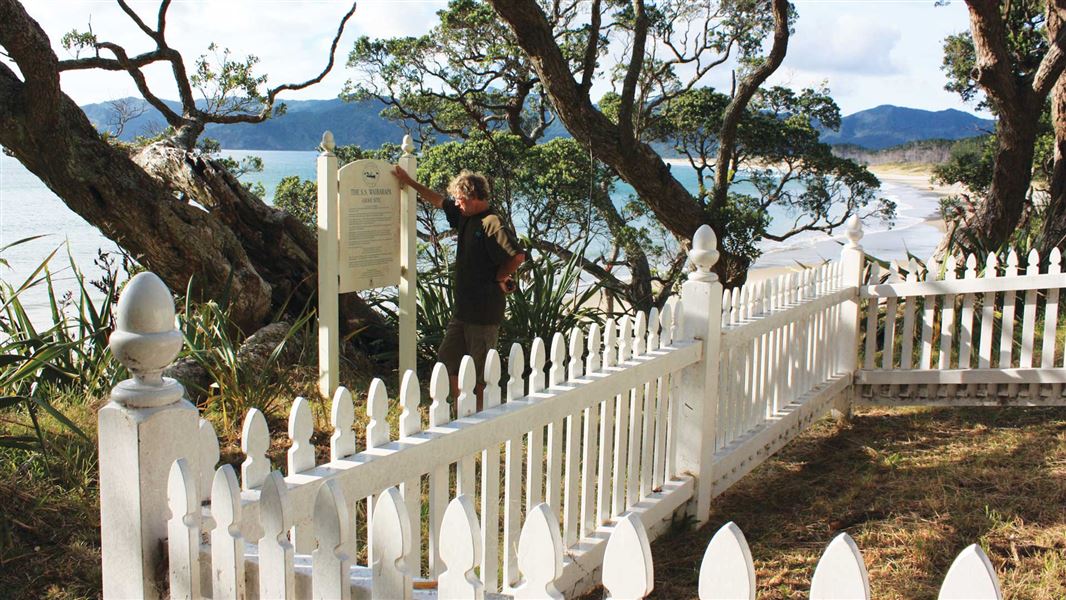One of the worst shipwrecks in New Zealand's maritime history, about 140 people drowned when the SS Wairarapa hit rocks near Miners Head on 29 October 1894.
Most of the dead from the shipwreck were taken back to Auckland. But some remain buried on the island in two small cemeteries.
Tapuwai site/SS Wairarapa Graves Walkway
Time: 30 min one way
From the road end follow the signposts to the beach. Turn left and wander along this beautiful beach to Tapuwai Point and grave sites surrounded by picket fence.
Getting there: The Tapuwai graves can be found at the north end of Whangapoua beach. From the road end follow the signposts to the beach. Turn left and walk along the beach to Tapuwai Point and the grave sites surrounded by picket fence.
Onepoto site
Time: 15 min one way
From the end of Kawa Road follow the signpost to the beach and wander or boulder hop along the beach to the graves.
Getting there: The Onepoto grave site is located at the south end of Kawa Road in Katherine Bay. From the end of Kawa Rd follow the signpost to the beach and walk along the beach to the graves.
The white picket fences around the graves have been restored and maintained over the years both by DOC staff and the community to replicate the original posts, pickets and rails. Some of the original pickets and corner posts that were constructed in 1894 are still in place today.
Interpretative ‘headstones’ were erected beside the cemeteries in 1994 to commemorate the centenary of the wreck.
These two grave sites – located in Onepoto and Tapuwai – serve as a reminder of the wreck of the SS Wairarapa.
The shipwreck
The SS Wairarapa was a first class steamer owned by the Union Steam Ship Company that carried both passengers and cargo between Australia and New Zealand.
On the 29th October 1894, the Wairarapa was sailing between Sydney and Auckland when it struck Miners Head, off Great Barrier Island. Of the 235 passengers and crew on board, it is thought that 130 people lost their lives, making this the third worst shipping disaster in New Zealand’s history.
Rescue was difficult because of the remote location of the shipwreck and the rough conditions. In the hours immediately after the wreck, two lifeboats rescued 50 people from the sea but other lifeboats were smashed by waves or rocks. Those survivors left on board either clung to the rigging or climbed to the ship's bridge. A steward swam to shore with a line and about 50 people were able to be hauled through the water to safety. The survivors huddled on the rocks for over 30 hours before being rescued by Ngati Rehua at Katherine Bay.
The grave sites
It is estimated that 60 unidentified bodies from the wreck were buried at Onepoto and Tapuwai Point while the others were transported for burial on the mainland. White picket fences enclosed both sites after the last of the victims were buried. Other burials located on Great Barrier Island are thought to have since been exhumed and transferred to the cemeteries at Onepoto and Tapuwai.
Ngati Rehua residents at Katherine Bay have a special relationship with the Onepoto grave site. As well as rescuing survivors and providing hospitality until they could be transported back to Auckland, they assisted in recovering the bodies of those who perished in the shipwreck.
Further reading
Locker-Lampson, S. and Francis, I. (1981) Eight minutes past Midnight: The wreck of the SS Wairarapa. Rowfant Books, Wellington.
Check you are pest-free
Check, clean, and seal your gear to ensure you don't bring pests, soil, and seeds.
DOC Customer Service Centre
| Phone: | 0800 275 362 |
| Email: | greatbarrier@doc.govt.nz |
| Address: | Aotea / Great Barrier Island Office |
